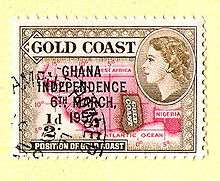Queen of Ghana
Not to be confused with Yaa Asantewaa.
| Queen of Ghana | |
|---|---|
|
| |
|
Queen Elizabeth II in profile on a stamp from the Gold Coast overprinted for Ghanaian independence, 1957 | |
| Details | |
| Style | Her Majesty |
| Formation | 6 March 1957 |
| Abolition | 1 July 1960 |
From 1957 to 1960, Ghana was an independent constitutional monarchy with Elizabeth II as its queen. She was also the Queen of the other Commonwealth realms, including the United Kingdom, and her constitutional roles in Ghana were delegated to a Governor-General.[1]
The Ghana Independence Act 1957 transformed the British Crown Colony of the Gold Coast into the independent sovereign state of Ghana with the Queen as head of state on 6 March 1957.[1] Ghana adopted a new constitution in 1960 that replaced the Queen and Governor-General on 1 July 1960 with a President.[1] Ghana became a republic within the Commonwealth.

The Queen meeting Ghanaian government minister Komla Agbeli Gbedemah and his wife, 1953
The Queen visited Ghana on 9–20 November 1961 and 7–9 November 1999.[2]
| Queen | ||||
| Name | Birth | Death | Consort | Heir apparent |
|---|---|---|---|---|
| Elizabeth II | 21 April 1926 | Prince Philip, Duke of Edinburgh | Charles, Prince of Wales | |
| Titles |
|---|
| Elizabeth II 6 March 1957 – 27 July 1957: By the Grace of God, of the United Kingdom of Great Britain and Northern Ireland and of Her other Realms and Territories Queen, Head of the Commonwealth, Defender of the Faith 27 July 1957 – 1 July 1960: Queen of Ghana and of Her other Realms and Territories, Head of the Commonwealth[3] |
See also
References
- 1 2 3 "After Independence". Judicial Service of Ghana. Retrieved 8 November 2015.
- ↑ "Commonwealth visits since 1952". Official website of the British monarchy. Royal Household. Retrieved 8 November 2015.
- ↑ "Ghana: Heads of State: 1957–1960". archontology.org. Retrieved 8 November 2015.
This article is issued from Wikipedia - version of the 7/25/2016. The text is available under the Creative Commons Attribution/Share Alike but additional terms may apply for the media files.

